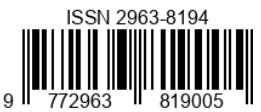SETTLEMENT OF THE INFLUENCE RETURN ON ASSETS, CURRENT RATIO, DEBT TO ASSETS RATIO ON COMPANY VALUE MODERATED BY FINANCIAL DISTRESS AND TOTAL ASSETS TURNOVER IN THE FOOD AND BEVERAGE SUB SECTOR LISTED ON THE SOUTHEAST ASIA STOCK EXCHANGE PERIOD 2012 – 2020
DOI:
https://doi.org/10.55606/jekombis.v1i1.1100Keywords:
Return On Assets, Current Ratio, Debt to Assets Ratio, Price Earning Ratio, Earning Per Share, Total Assets TurnoverAbstract
This study aims to determine the effect of Return On Assets, Current Ratio, and Debt to Assets Ratio on company value, which is moderated by Financial Distress and Total Assets Turnover in the food and beverage sub -sector which is listed on the Southeast Asian Stock Exchange for the 2012-2020 period. The data collected is secondary data with the documentation method in the form of the company's annual report. The analytical tool used to test the hypothesis is SPSS 26. The population in this study are companies in the Food and Beverage subsector which are listed on the Southeast Asian Stock Exchange with a total population of 147 companies. The sampling method used in this study used a purposive sampling technique in order to obtain 12 companies with a sample of 108 samples. The analysis technique used is multiple linear regression analysis, moderating regression analysis (MRA), partial test, and simultaneous test. The results of the study partially concluded that Return On Assets had no partial effect on the Price Earning Ratio, the Current Ratio had a significant effect on the Price Earning Ratio, and the Debt to Assets Ratio had a significant effect on the Price Earning Ratio. The results of the study simultaneously show that Return On Assets, Current Ratio, and Debt to Assets Ratio have a significant effect on the Price Earning Ratio. In moderation Earning Per Share is able to moderate the relationship between Return On Assets and Current Ratio to Price Earning Ratio, Earning Per Share is not able to moderate the relationship between Debt to Assets Ratio to Price Earning Ratio, Moderating Total Assets Turnover is not able to moderate the relationship between Return On Assets and Current Ratio to Price Earning Ratio, Total Assets Turnover is able to moderate the relationship between Debt to Assets Ratio to Price Earning Ratio.
Downloads
References
Suripto. (2015). Financial Management: Corporate Value Creation Strategy Through Economic Value Added Approach. 1st Edition. Bandung: Alphabet.
Eduardus Tandelilin., (2017), Capital Market Portfolio & Investment Management, Depok: PT. Canisius.
Fahmi, Irham. (2015). Introduction to Financial Management Theory and Questions and Answers. Bandung: Alphabet.
Fahmi, Irham. (2016). Introduction to Financial Management. Bandung : ALPHABETA
Fahmi, Irham. (2017). Financial Statement Analysis. Bandung: Alphabet.
Ghozali, Imam. (2018). Multivariate Analysis Application with IBM SPSS 25 Program. Diponegoro University Publishing Agency: Semarang
Harry. (2016). Financial Statement Analysis. Integrated and Comprehensive Edition. Jakarta: Grasindo
Harry. (2018). Introduction to Management. First Print. PT Grasindo. Jakarta.
Indonesian Bankers Association. (2016). Bank Risk Management Strategy. Jakarta: Main Library Gramedia.
Kamaludin. (2015). Merger and Acquisition Restructuring. Bandung: PT Raja Grafindo Persada.
Cashmere. (2015). Financial Statement Analysis. Edition One. Jakarta: PT RajaGrafindo Persada.
Cashmere. (2016). Financial Statement Analysis. Jakarta: Raja Grafindo Persada.
Cashmere. (2017). Financial Statement Analysis. Jakarta: PT Rajagrafindo Persada.
Sianturi, M Wanti Ernita. (2015). The Influence of Financial Performance on the Value of Manufacturing Companies in the Consumer Goods Industry Sector on the IDX. eJournal of Business Administration, Volume 3, Number 2
Sugiyono. (2017). Quantitative Research Methods, Qualitative, and R&D. Bandung : Alfabeta, CV.
Yustika, Yeni. (2015 ). The Influence of Liquidity, Leverage, Profitability, Operating Capacity and Managerial Agency Costs on Financial Distress (Empirical Study of Manufacturing Companies Listed on the Indonesia Stock Exchange in 2011-2013). Let's FEKON Vol. 2 No. October 2, 2015.
Journal Source:
Abbas, A., & Arizah, A. (2019). Marketability, profitability, and profit-loss sharing: evidence from sharia banking in Indonesia. Asian Journal of Accounting Research, 4 (2), 315–326. https://doi.org/10.1108/AJAR-08-2019-0065
Averio, T. (2020). The analysis of influencing factors on the going concern audit opinion – a study in manufacturing firms in Indonesia. Asian Journal of Accounting Research, 6 (2), 152–164. https://doi.org/10.1108/AJAR-09-2020-0078
Fajaria, AZ (2018). The Effect of Profitability, Liquidity, Leverage and Firm Growth of Firm Value with its Dividend Policy as a Moderating Variable. International Journal of Managerial Studies and Research, 6 (10), 55–69. https://doi.org/10.20431/2349-0349.0610005
Fatma, N., & Hidayat, W. (2019). Earnings persistence, earnings power, and equity valuation in consumer goods firms. Asian Journal of Accounting Research, 5 (1), 3–13. https://doi.org/10.1108/AJAR-05-2019-0041
Gunawan, IMA, Pituringsih, E., & Widyastuti, E. (2018). the Effect of Capital Structure, Dividend Policy, Company Size, Profitability and Liquidity on Company Value (Study At Manufacturing Companies Listed on Indonesia Stock Exchange 2014-2016). International Journal of Economics, Commerce and Management United Kingdom, VI (2017), 107–117. http://ijecm.co.uk/
Mangesti Rahayu, S. (2019). Mediation effects of financial performance toward influences of corporate growth and assets utilization. International Journal of Productivity and Performance Management, 68 (5), 981–996. https://doi.org/10.1108/IJPPM-05-2018-0199
Moch, R., Prihatni, R., & Buchdadi, AD (2019). The effect of liquidity, profitability and solvency to the financial distress of manufactured companies listed on the Indonesia stock exchange (IDX) period of year 2015-2017. Academy of Accounting and Financial Studies Journal, 23 (6), 1–16.
Rangkuti, Z. (2020). The effects of Tier-1 capital to risk management and profitability on performance using multiple fixed effect panel data models. Measuring Business Excellence, 25 (2), 121–137. https://doi.org/10.1108/MBE-06-2019-0061
Salehi, M., Lotfi, A., & Farhangdoust, S. (2017). The effect of financial distress costs on ownership structure and debt policy: An application of simultaneous equations in Iran. Journal of Management Development, 36 (10), 1216–1229. https://doi.org/10.1108/JMD-01-2017-0029
Scalzer, RS, Rodrigues, A., Macedo, M. Á. da S., & Wanke, P. (2019). Financial distress in electricity distributors from the perspective of Brazilian regulation. Energy Policy, 125 (August 2018), 250–259. https://doi.org/10.1016/j.enpol.2018.10.018
Other Sources:
www.idx.co.id
www.set.or.th
www.sgx.com
www.bursamalaysia.com
www.pse.com.ph
Downloads
Published
How to Cite
Issue
Section
License
Copyright (c) 2022 Jurnal Penelitian Ekonomi Manajemen dan Bisnis

This work is licensed under a Creative Commons Attribution-ShareAlike 4.0 International License.







